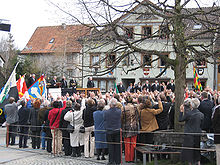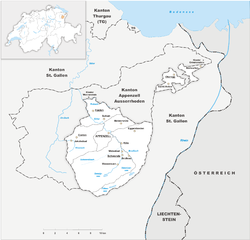- Appenzell Innerrhoden
-
Kanton Appenzell Innerrhoden — Canton of Switzerland — 
Coat of armsCoordinates: 47°18′N 9°24′E / 47.3°N 9.4°ECoordinates: 47°18′N 9°24′E / 47.3°N 9.4°E Capital Appenzell Subdivisions 6 districts Government – Executive Standeskommission (7) – Legislative Landsgemeinde
Grosser Rat (49)Area[1] – Total 172.52 km2 (66.6 sq mi) Population (12/2009)[2] – Total 15,681 – Density 90.9/km2 (235.4/sq mi) Highest point 2,502 m (8,209 ft) - Säntis Lowest point 560 m (1,837 ft) - Appenzell Ausserrhoden and St. Gallen border Joined 1513 Abbreviation AI Languages German Website AI.ch Appenzell Innerrhoden (German:
 Appenzell Innerrhoden (help·info); in English sometimes Appenzell Inner Rhodes) is the smallest canton of Switzerland by population and the second smallest by area, Basel-City having less area.
Appenzell Innerrhoden (help·info); in English sometimes Appenzell Inner Rhodes) is the smallest canton of Switzerland by population and the second smallest by area, Basel-City having less area.Contents
History
Foundation
The name Appenzell (Latin: abbatis cella) means "cell (i.e., estate) of the abbot". This refers to the Abbey of St. Gall, which exerted a great influence on the area. By the middle of the 11th century the abbots of St Gall had established their power in the land later called Appenzell, which, too, became thoroughly teutonized, its early inhabitants having probably been romanized Raetians.
By about 1360, conflicts over grazing rights, taxes, and tithes were causing concern for both the abbot and the farmers of Appenzell. Both parties wanted to protect their rights and interests by joining the new Swabian League. In 1377 Appenzell was allowed to join the League with the support of the cities of Konstanz and St. Gallen (the city of St. Gallen was often at odds with the neighboring Abbey of St. Gall). With the support of League, Appenzell refused to pay many of the gifts and tithes that the Abbot Kuno von Stoffeln demanded. In response to the loss of revenue from his estates, Kuno approached the Austrian House of Habsburg for help. In 1392 he made an agreement with the Habsburgs, which was renewed in 1402. In response, in 1401 Appenzell entered into an alliance with the city of St. Gallen to protect their rights and freedom[3].
Independence and joining the Swiss Confederation
Main article: Appenzell WarsFollowing increasing conflicts between the Appenzellers the abbot's agents, including the bailiff of Appenzell demanding that a dead body be dug up because he wanted the man's clothes[4], the Appenzellers planned an uprising. On a certain day, throughout the abbot's lands, they attacked the bailiffs and drove them out of the land. Following unsuccessful negotiations Appenzell and St. Gallen entered into a treaty. The treaty between St. Gallen and Appenzell marked a break between the abbot and his estates. Perhaps fearing the Habsburgs, in 1402 the League expelled Appenzell. During the same year, St. Gallen reached an agreement with the abbot and Appenzell could no longer count on St. Gallen's support. Appenzell declared itself ready to stand against the abbot, and in 1403 formed an alliance with the Canton of Schwyz, a member of the Old Swiss Confederation that had defeated the Austrians in the last century. Glarus provided less support, but authorized any citizen who wished to support Appenzell to do so.[4] In response, the League raised an army and marched to St. Gallen before heading toward Appenzell. On 15 May 1403, they entered the pass to Speicher and outside the village of Vögelinsegg met the Appenzell army. A small force of Appenzell and Confederation troops defeated the League army and signed a short lived peace treaty.
Following another Appenzell victory on 17 June 1405, at Stoss Pass on the border of Appenzell town, the new canton continued to expand.[3]. During the expansion, Appenzell had even captured the abbot of St Gall and in response they were excommunicated by the Bishop of Constance[4].
However, while the Bund expanded the Austrians used the peace to regain their strength. On September 11, 1406 an association of nobles formed a knightly order known as the Sankt Jörgenschild (Order of St. George's Shield) to oppose the rebellious commoners of the Bund[5]. Following a defeat at Bregenz, Appenzell was unable to hold the Bund together. The city of St. Gallen and the Canton of Schwyz each paid off the Austrians to avoid an attack, and the Bund was dissolved by King Rupert on April 4, 1408[3].
As part of the peace treaty, the abbot gave up his ownership of Appenzell, but was still owed certain taxes.[4] However, it wasn't until 1410 that the area was at peace.[3]
In 1411 Appenzell signed a defensive treaty with the entire Swiss Confederation (except Bern), which strengthened their position against the abbot. Appenzell joined the Confederation as an "Associate Member", and wouldn't become a full member until 1513. Following another battle, in 1429, Appenzell was granted freedom from the obligations in the future. This treaty represented the end of Appenzell's last financial tie to the Abbey of St. Gall, and a movement to closer relationships with the Confederation[3].
Division of Appenzell
Starting in 1522, followers of Martin Luther and Huldrych Zwingli began to preach the Protestant Reformation in Appenzell. The early reformers had the most success in the outer Rhoden, a term that in the singular is said to mean a "clearing," and occurs in 1070, long before the final separation. Following the initial small success, in 1523 Joachim von Watt (also known as Joachim Vadian) began to preach the reformed version of the Acts of the Apostles to friends and fellow clergy. His preaching brought the Reformation into the forefront of public debate. In October 1523, the Council supported the Protestant principle of scriptural sermons and on 24 April 1524 Landsgemeinde confirmed the Cantonal Council's decision. However, the work of the Anabaptists in the Appenzell region (as well as in Zurich and St. Gallen) in 1525 led to government crackdowns. The first police action against the Anabaptists took place in June 1525, followed by the Anabaptist Disputation in Teufen in October 1529.[6]
To end the confrontation between the old and new faiths, the Landesgemeinde decided in April 1525, that each parish should choose a faith, but that the principle of free movement would be supported, so that the religious minority could attend the church of their choice regardless of where they lived. The entire Appenzell Ausserrhoden (except Herisau, where Joseph Forrester convinced them to remain Catholic) converted to the Reformation in 1529. The Innerrhoden (except for Gais) remained with the old faith. While the majority of the residents of Appenzell town remained Catholic under Pastor Diepolt Huter, there was a strong Reformed minority. In 1531, the minority were nearly successful in getting the town to ally with the Protestant Ausserrhoden. But an armed mob of angry residents from the neighboring village of Gonten prevented the abolition of the Mass in Appenzell. The Catholic victory in the Second War of Kappel in 1531 ended plans for a reformation of the entire Canton of Appenzell.[6]
After the Second War of Kappel, the two religions reached a generally peaceful parity. They remained united by common business interests, the same political and legal understanding, a shared desire to form an alliance with France and a shared opposition to the city of St. Gallen. This shared opposition to St. Gallen was demonstrated in the so-called linen affairs (1535-42, 1579), where the weavers throughout Appenzell supported each other when they felt that they were unfairly treated by the linen industry of St. Gallen.[6]
From 1798 to 1803 Appenzell, with the other domains of the abbot of St Gall, was formed into the canton of Säntis of the Helvetic Republic, but in 1803, on the creation of the new canton of St Gall, shrank back within its former boundaries.
Appenzell Innerrhoden was the last canton to grant women the right to vote, being forced to do so only in 1990 when some women of Appenzell filed suit in the Switzerland Federal Supreme Court and won. It also recorded the highest vote in favour of the ban on minarets in the 2009 referendum.
Geography
Most of the canton is pastoral, this despite being mountainous. The Säntis peak in the Appenzell Alps is one of the main attractions of the canton. There are three small mountain lakes in the canton: Seealpsee, Sämtisersee and Fälensee.
Political subdivisions
In Appenzell Innerrhoden districts are the lowest administrative division: the canton is not subdivided in municipalities. Because of that, for firefighting, energy and water, the town Appenzell has a special-purpose municipality, the Feuerschaugemeinde.
The Canton is divided into 6 districts:
- Appenzell
- Gonten
- Oberegg
- Rüte
- Schlatt-Haslen
- Schwende
Government
 Landsgemeinde in Appenzell Innerrhoden
Landsgemeinde in Appenzell Innerrhoden
Appenzell is the capital of this canton. The constitution was established in 1872. Citizens from the canton assemble every last Sunday of April for the Landsgemeinde (general assembly) in a square in Appenzell, vote on laws and elect the Governing Council.
In 1991, following a decision by the Federal Supreme Court of Switzerland, Appenzell Innerrhoden became the last Swiss canton to grant women the vote on local issues.[7]
Demographics
The population of the canton (as of 31 December 2009) is 15,681.[2] As of 2007[update], the population included 1,510 foreigners, or about 9.76% of the total population.[8] Due to the split of Appenzell along religious lines, the population (as of 2000[update]) is nearly all Roman Catholic (81%), with a small Protestant minority (10%).[9]
Economy
Cattle breeding and dairy farming are the main agricultural activities: Appenzeller cheese is widely available throughout Switzerland. Somewhat before the early 2000s, the idyllic countryside of Appenzell Innerrhoden apparently became popular with nudists, and at the 2009 Landsgemeinde the canton's residents voted to prohibit naked hiking. Violators would be fined.[10] However nudists who appealed against their fines to the federal court have been reimbursed by the local authorities, as nudism is not a crime under Swiss federal law which takes precedence.[11] It is common for cars rented in Switzerland to be registered in Appenzell Innerrhoden, and thus having license plates starting with "AI", because of the reduced tax on cars in this canton.
References
- ^ Arealstatistik Standard - Kantonsdaten nach 4 Hauptbereichen
- ^ a b Swiss Federal Statistical Office, MS Excel document – Bilanz der ständigen Wohnbevölkerung nach Kantonen, Bezirken und Gemeinden (German) accessed 25 August 2010
- ^ a b c d e Appenzell War in German, French and Italian in the online Historical Dictionary of Switzerland.
- ^ a b c d Williams, Henry Smith (1908). The Historians' History of the World. 16. Hooper & Jackson. pp. 581–583. http://books.google.com/books?id=zLEVAAAAYAAJ&pg=PA581#PPA583,M1.
- ^ Order of St. George's Shield in German, French and Italian in the online Historical Dictionary of Switzerland.
- ^ a b c Appenzell Canton - The Reformation in German, French and Italian in the online Historical Dictionary of Switzerland.
- ^ United Nations press release of a meeting of the Committee on the Elimination of Discrimination against Women (CEDAW), issued on the 14 January 2003
- ^ Federal Department of Statistics (2008). "Ständige Wohnbevölkerung nach Staatsangehörigkeit, Geschlecht und Kantonen" (Microsoft Excel). http://www.bfs.admin.ch/bfs/portal/de/index/themen/01/02/blank/key/raeumliche_verteilung/kantone__gemeinden.html. Retrieved 5 November 2008.
- ^ Federal Department of Statistics (2004). "Wohnbevölkerung nach Religion" (Interactive Map). http://www.bfs.admin.ch/bfs/portal/de/index/themen/01/05/blank/key/religionen.html. Retrieved 15 January 2009.
- ^ Swiss canton bans nude hiking (Reuters, Mon 27 Apr 2009)
- ^ Swiss naked hiker's appeal upheld (BBC 28 May 2010)
External links
- Official website (English)
- Official statistics
- List of castles and fortresses in Switzerland
- Säntis (German)
 Media related to Appenzell Innerrhoden at Wikimedia Commons
Media related to Appenzell Innerrhoden at Wikimedia Commons
Three Cantons · Eight Cantons · Thirteen Cantons · coats of arms historical cantons: Unterwalden ·
Unterwalden ·  Basel ·
Basel ·  Appenzell · Baden · Bellinzona · Fricktal · Léman · Linth · Lugano · Oberland · Raetia · Säntis · WaldstättenCategories:
Appenzell · Baden · Bellinzona · Fricktal · Léman · Linth · Lugano · Oberland · Raetia · Säntis · WaldstättenCategories:- Cantons of Switzerland
- Imperial valleys
- Appenzell Innerrhoden
Wikimedia Foundation. 2010.



